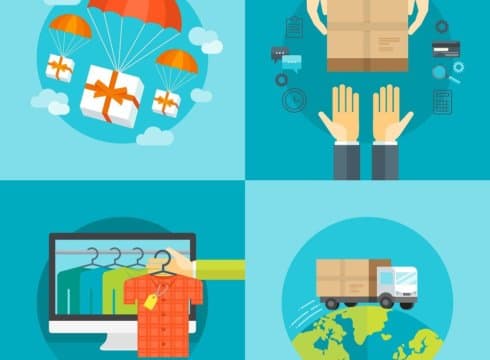Inc42 Daily Brief
Stay Ahead With Daily News & Analysis on India’s Tech & Startup Economy
A report by Bank of America Merrill Lynch in 2015 stated that the ecommerce market in India will be worth $220 billion by 2025. This growth is said to be driven by factors such as young demographic profile, increasing internet penetration and relative better economic performance. Also, according to eMarketer, online retail is estimated to have topped $1.316 Trillion in 2014, i.e. 5.9% of the overall retail sales of $22.4 Trillion last year.
One factor critical to this growth is ecommerce logistics or ecommerce fulfillment. Fulfillment involves picking, packaging and shipping of products once an order is placed on the website.
The Indian Ecommerce Fulfillment Industry: Current Status
In a recently released World Bank report of Logistics Performance Index (LPI), India ranked at the 35th position among 160 countries/ranks. This reflects the ease of doing business and a better movement of the goods inside the country as well as a large scope for reliable logistics service providers in many emerging countries.
According to a recent report by Vinculum, a software company enabling multi-channel retailing in ecommerce, the sector has seen over $500 Million invested in 2015 by Indian investors alone, with an aim to create third-party logistics (3PL) focused on ecommerce fulfillment.
This has also created new revenue streams for the players in the ecommerce ecosystem, but has also impacted supply chain processes and choice of IT systems.
Quick Facts
- B2B ecommerce market is expected to reach $700 Billion while B2C market is expected to reach $ 102 Billion by 2020.
- While a large share (as much as 50 percent) of the e-commerce logistics market is commanded by in-house logistics players, the other 50 percent is controlled by third-party logistics (3PLs) service providers including traditional Logistics Service Providers (LSPs), e-commerce focused logistics providers and India Post.
- Major ECommerce players are building their own fulfillment infrastructure. For instance, the online marketplace companies have together rented about 3.6 Million sq. ft of warehouse space in the country, half of which was added in 2015 alone.
- Nearly 25% of the total warehouse absorption is being taken up by ecommerce players.
- The logistics cost for ecommerce retailers can be split across the components of consolidation, sorting, line-haul and last mile delivery (this comprises a major chunk of the fulfillment costs).
- The logistics sector specific to e-commerce retailing in India was valued at USD0.2 billion in 2014 and is projected to witness a CAGR of ~48 per cent in the upcoming five years to reach USD2.2 billion by 2020.
- The market potential for fulfilment centres is estimated to increase from about $34 Mn in FY14 to approximately $430 Mn by FY20, depending upon a commodity-wise preference to outsource and vendor preferences.
Major Challenges Faced By Online Retailers
The Indian logistics industry currently seems to be fragmented and underdeveloped, facing various issues such as last mile delivery, workforce management, cultural diversities, no real time coordination, and late deliveries.
Customer returns are a major challenge for any online retailer. Also, their ability to quickly process these returns – return to the appropriate warehouses and then provide refunds to the customers – is one of the chief contributors to the customer experience.
Another major issue is logistical complexity, which consumes a huge amount of capital and time to solve it. There are difficulties faced in overcoming complex routing problems. Also, ecommerce players are struggling to chart out strategies to deal with reverse ecommerce and tackle COD (Cash on Delivery).
Outsourcing the Last Mile Delivery
One can either own or outsource the last mile delivery. Self-fulfillment, however, comes at a cost, which can only be managed with economies of scale as then the average fulfillment cost per customer is reduced.
For ecommerce startups in the early phase of growth, outsourcing the fulfillment services from third party logistics service providers seems more sensible. For instance, Amazon and eBay offer their own fulfillment services to the connected sellers. For those operating independently, there are various multi-channel fulfillment providers available which take care of every process right from receiving the order from the customer to delivering at the door-step.
The Road Ahead
One should not disturb the existing B2B processes to meet the needs of the online customer. Instead, it is necessary to develop supply chain processes suited to the online customer, thereby setting up separate ecommerce fulfillment hubs or work strategically with 3PLs focused on ecommerce fulfillment.
At the same time, it is critical to choose a Warehouse Management system fulfilling requirements such as ready integration to marketplaces/ web shops, ready integrations to transporter systems, order management, client-wise segregation of inventory, serial tracking, and real-time view of inventory to the 3PL’s customers.
Multi-currency & Multilingual capabilities are also very important with the increasing trend of cross-border fulfillment. With increased adoption of hand-held devices & android apps- mobile readiness of such solutions is considered a hygiene factor.
Customers today expect to research online, buy in the store; research in store, buy online, have the flexibility to pay on delivery, buy in one store, return in the other, look up inventory online before visiting store, buy online pickup in store etc. The channels are blurring and brick and mortar retailers need to have a strategic presence online for them to be able to capture this opportunity.
A few successful stories of tech adoption for fulfillment in B2B & B2C verticals can be found here.
This post is powered by Vinculum.
{{#name}}{{name}}{{/name}}{{^name}}-{{/name}}
{{#description}}{{description}}...{{/description}}{{^description}}-{{/description}}
Note: We at Inc42 take our ethics very seriously. More information about it can be found here.


